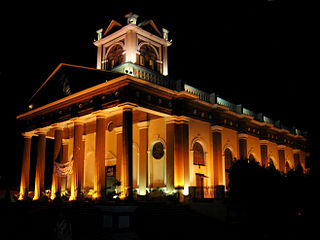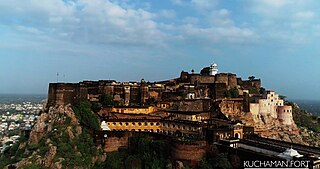
Chhindwara is a village in India and a Municipal Corporation in the Chhindwara district in the Indian state of Madhya Pradesh. The city is the administrative headquarters of Chhindwara District. Chhindwara is reachable by rail or road from adjacent cities Betul, Jabalpur and Nagpur. The nearest airports are in Nagpur,Mumbai,New Delhi and Srinagar (130 km); however there is a small airport located in the village
- which is not serviceable for passenger planes.

Kapurthala is a city in Punjab state of India. It is the administrative headquarters of Kapurthala District. It was the capital of the Kapurthala State, a princely state in British India. The aesthetic mix of the city with its prominent buildings based on French and Indo-Saracenic architecture self-narrate its princely past. It is also known as city of Palaces & Gardens. According to the 2011 census, Kapurthala is the least populated city in India.

Mahur or Mahurgad is a town and religious place in Nanded district of Maharashtra, India. Mahur is the birthplace of Hindu God Dattatreya. Dattatreya parents Atri Rishi and Sati Anasuya Mata lived here. Brahmadev, Vishnudev and Lord Shiva once got a news about Anusaya Mata that there is no one more pious and pure as her. To test her piousness they arrived under the garb of asking Alm (bhiksha). Near Mahur, There is a Pious confluence of River Penganga and River Pus at Hiwara Sangam village, Tal. Mahagaon Vidarbha, from where the river flows northward. Penganga river forms a border between Vidarbha and Marathwada. Mahur falls just about 3kms inside Marathwada due to river banks.

Jagadhri is a city and a municipal council in the Yamunanagar district of the Indian state of Haryana. This town lies adjacent to the city of Yamunanagar. The demarcation line between the two is difficult to discern. Jagadhri is around 90 km away from Chandigarh, the capital city of Haryana state. This town is known for the cluster of brass and copper industries. Jagadhri is known as the "Brass City" of India.

Matsyendranātha, also known as Matsyendra, Macchindranāth, Mīnanātha and Minapa was a saint and yogi in a number of Buddhist and Hindu traditions. He is considered the revivalist of hatha yoga as well as the author of some of its earliest texts. He is also seen as the founder of the natha sampradaya, having received the teachings from Shiva. He is associated with Kaula Shaivism. He is also one of the eighty-four mahasiddhas and considered the guru of Gorakshanath, another known figure in early hatha yoga. He is revered by both Hindus and Buddhists and is sometimes regarded as an incarnation of Avalokiteśvara.
Ahore or Ahor (Aavar) is a city in the Jalore District of the Indian state of Rajasthan. Strategically located at intersection of Sanderao-Jalore and Jalore-Jodhpur Highway and is a great commercial hub catering to almost all nearby villages and towns. Nearby Railway Stations are Jalore, Falna and Jodhpur and Jodhpur is the nearest Airport. The Rajasthan Vidhan Sabha Constituency is Ahore itself.

The Fort of Gwalior or the Gwalior Fort is a defence hill fort in Gwalior, India. Mughal Emperor Babur called it the "pearl amongst the fortresses of Hind" because of its impregnability and magnificence and it has also been nicknamed the Gibraltar of India. The history of the fort goes back to the 5th century or perhaps to a period still earlier. The old name of the hill as recorded in ancient Sanskrit inscriptions is Gopgiri. The current structure of the fort has existed at least since the 8th century, and the inscriptions and monuments found within what is now the fort campus indicate that it may have existed as early as the beginning of the 6th century, making it one of India's oldest defence forts still in existence. The modern-day fort, embodying a defensive structure and two palaces was built by the Tomar Rajput ruler Man Singh Tomar. It has witnessed the varying fortunes of the Guptas, the Hunas, the Pratiharas, the Kachhwahas, the Tomaras, the Pathans, the Surs, the Mughals, the English, the Jats, and the Marathas represented by the powerful Scindia dynasty who have left their landmarks in the various monuments which are still preserved.

Jalore Fort is the main attraction of Jalore, a town in the Indian state of Rajasthan, and one of the nine forts of the Maru, under the Paramaras in the 10th century. It is one of the most famous and impressive forts in the state and has been known through history as the Svangiri or the "golden mount".From this fort, the Songra Chauhans defeated the Delhi Sultanate ruler Alauddin Khalji. With the blessings of Kuldevi Maa Ashapura who is also known as Modara Mata. Chauhan gave a different direction to Jalore and to the fort.

Sundha Mata temple is a nearly 900-year-old temple of Mother goddess Chamunda situated on a hilltop called Sundha, located at longitude 72.367°E and latitude 24.833°N, in Jalore District of Rajasthan, India. It is 64 km (40 mi) from Mount Abu and 20 km (12 mi) from the town of Bhinmal.
Kishangarh Renwal is a city and a municipality, panchayat samiti in Jaipur district in the Rajasthan state of India.State Highway 19A passing through the city.

Kuchaman City is a Municipal Council and District Headquarters of Didwana-Kuchaman District located in west-central Rajasthan, India. It is the largest city of newly Kuchaman district. The Didwana-Kuchaman district was carved out from the Nagaur District as the 38th District of the state of Rajasthan on 4 August 2023.

Chintpurni is a small town in the Una district of Himachal Pradesh about 40 km north of Una, not far from the border with the Indian state of Punjab. The elevation is about 977 meters. It is home to the Maa Chintpurni Temple which is a major pilgrimage site as one of the Shakti Peethas in India. The Hindu genealogy registers at Chintpurni, Himachal Pradesh are kept here. North of Chintpurni are the western Himalayas. Chintpurni lies within the much lower Shiwalik range.

In Hinduism, the yatra (pilgrimage) to the tirthas has special significance for earning the punya needed to attain the moksha (salvation) by performing the darśana, the parikrama (circumambulation), the yajna, the Dhyana, the puja (worship), the prarthana, the dakshina, the seva, the bhandara, etc. These sacred places are usually located on the banks of sacred waters, such as sacred rivers or their tributaries, the kundas, the ghats, or the stepwells, or the temple tanks.

Jwala/Jwala Ji is a Hindu goddess. The physical manifestation of Jwala is always a set of eternal flames, and the term Jvala means flame in Sanskrit and ji is an honorific used in the Indian subcontinent.

Ratneshwar Mahadev Mandir is one of the most photographed temples in the holy city of Varanasi in Uttar Pradesh, India. The temple, while apparently well-preserved, leans significantly towards the back side (north-west), and its garbhagriha is generally below the water much of the year, except for a few months during the summer. The Ratneshwar Mahadev Temple is situated at Manikarnika Ghat, Varanasi. The temple has developed a nine-degree slant.
Umarlai Khalsa is a village in Barmer District of Rajasthan state in India. It is about 100 km from Jodhpur. The town is famous for farming, Mata Nagnechiyaa Temple and Akhada, The town is well connected with Jodhpur by buses at frequent intervals. From Umarlai Khalsa towards Jalore there is India's Third Brahma Temple in the village of Asotra. From Umarlai Khalsa towards Barmer there is Ancient Temple of Lord Shri Vishnu named as Shri Ranchore Ray, Khed Mandir in the village of Khed The name Umarlai Khalsa derived from all the religious people of this village. About 13 km from Balotra is located the famous Jain Temple Nakoda. The place receives religious devotees from across India. The town is located near on the coast of the river Luni. The village of Umarlai Khalsa is mainly popular for housing the famous Ancient Temples of Lord Shiva. It is one of the most revered pilgrimage destinations for the Hindu community. The temple is an excellent example of fine architecture and many sculptures are carved inside the temple. Apart from this temple, a number of other temples are located in the town which include the Pabuji Rathord Mandir, Jog Maya Matha Mandir, Gogaji Mandir, Bhomiyaji Mandir, Hanuman Mandir and more.














